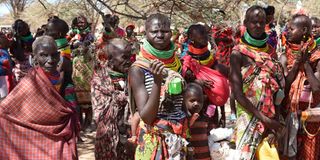Despite rains, millions of Kenyans to continue sleeping hungry

Locals wait for their rations of relief food distribution by President William Ruto to hunger victims due to drought, at Nakaalei in Turkana County on November 5, 2022.
What you need to know:
- The report titled Global Report on Food Crises 2023 highlights the alarming increase in acute food insecurity in Kenya and other countries in the region.
- According to the report, approximately 5.4 million Kenyans are already grappling with a food crisis, the highest number recorded in the history of the region. While drought has traditionally been blamed for such crises, the current situation is different. Even in areas where food is available, skyrocketing prices and widespread poverty have left millions unable to afford basic sustenance.
A new report has revealed that millions of Kenyans are on the brink of starvation unless immediate action is taken to address the dire food situation.
The report titled Global Report on Food Crises 2023 highlights the alarming increase in acute food insecurity in Kenya and other countries in the region.
According to the report, approximately 5.4 million Kenyans are already grappling with a food crisis, the highest number recorded in the history of the region. While drought has traditionally been blamed for such crises, the current situation is different. Even in areas where food is available, skyrocketing prices and widespread poverty have left millions unable to afford basic sustenance.
The Igad Climate Prediction and Applications Center based in Dagoretti-Corner has projected that millions of people will require emergency food assistance throughout the year regardless of harvest from the current season or the ongoing rains in some parts of the country. The report identifies Kenya and Somalia as the countries experiencing the most significant increases in acute food insecurity since 2021.
The Integrated Food Security Phase Classification scale was used to assess the severity of the crisis, placing Kenya at level three or higher. The report predicts that up to 30 million people in the region will require humanitarian food assistance, with 7.5 million people in Kenya, Somalia, South Sudan, and Sudan facing large food consumption gaps.
The compounding effects of multiple shocks, including prolonged drought, flooding, conflicts and economic challenges aggravated by Covid-19 and the war in Ukraine have contributed to the worsening situation. Climate extremes remain the primary driver of food insecurity in Ethiopia, Kenya, Somalia, and Uganda, where 35.85 million people are facing high levels of acute food insecurity.
The report serves as a wake-up call for immediate and collective action to address the root causes of food insecurity. Urgent measures are needed to prevent future climate emergencies by implementing climate adaptation strategies and upscaling anticipatory actions. Efforts to sustainably build peace, increase domestic production, and reduce post-harvest losses are also crucial to combating food insecurity caused by conflicts and global economic shocks, according to the report.
The situation is even worse in neighbouring countries such as Sudan, where the ongoing conflict has severely impacted food availability and access. The report warns that Khartoum and the region of Darfur are expected to experience a rapid deterioration in food security and nutrition. Over one million people have been displaced, further exacerbating the already alarming levels of food insecurity and malnutrition in the region.
Experts emphasise the need for immediate intervention to address the crisis. Dr Workneh Gebeyehu, IGAD Executive Secretary, stated that the high hunger levels in the region are a result of climate extremes, conflicts, and economic shocks. Urgent action is required to protect the lives of millions of vulnerable children, men, and women.
Dr Chimimba David Phiri, the subregional coordinator for Eastern Africa at the Food and Agriculture Organization , echoed the call for action, emphasising the importance of addressing the root causes of food insecurity and implementing anticipatory measures and climate adaptation strategies.




